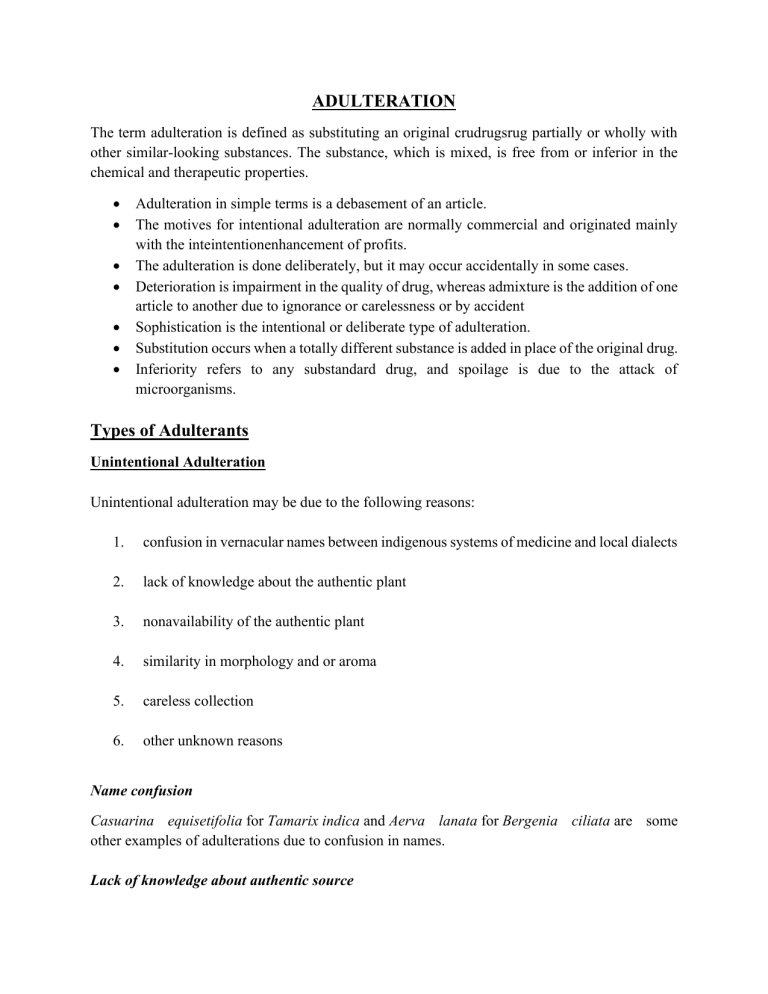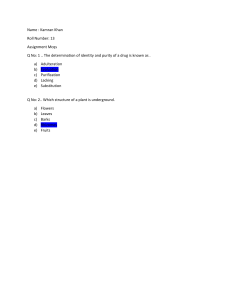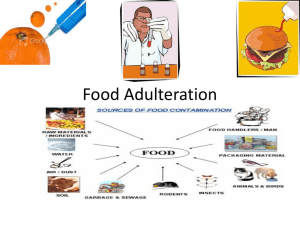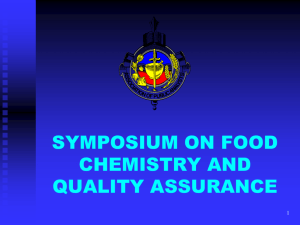
ADULTERATION The term adulteration is defined as substituting an original crudrugsrug partially or wholly with other similar-looking substances. The substance, which is mixed, is free from or inferior in the chemical and therapeutic properties. • • • • • • • Adulteration in simple terms is a debasement of an article. The motives for intentional adulteration are normally commercial and originated mainly with the inteintentionenhancement of profits. The adulteration is done deliberately, but it may occur accidentally in some cases. Deterioration is impairment in the quality of drug, whereas admixture is the addition of one article to another due to ignorance or carelessness or by accident Sophistication is the intentional or deliberate type of adulteration. Substitution occurs when a totally different substance is added in place of the original drug. Inferiority refers to any substandard drug, and spoilage is due to the attack of microorganisms. Types of Adulterants Unintentional Adulteration Unintentional adulteration may be due to the following reasons: 1. confusion in vernacular names between indigenous systems of medicine and local dialects 2. lack of knowledge about the authentic plant 3. nonavailability of the authentic plant 4. similarity in morphology and or aroma 5. careless collection 6. other unknown reasons Name confusion Casuarina equisetifolia for Tamarix indica and Aerva lanata for Bergenia ciliata are some other examples of adulterations due to confusion in names. Lack of knowledge about authentic source Nagakesar’ is one of the important drugs in ayurveda. The authentic source is Mesua ferrea. However, market samples are adulterated with flowers of Calophyllum inophyllum. Though the authentic plant is available in plenty throughout the Western Ghats and parts of the Himalayas, suppliers are unaware of it. Similarity in morphology Mucuna pruriens is the best example for unknown authentic plant and similarity in morphology. It is adulterated with other similar papilionaceae seeds. M. utilis (sold as white variety) and M. deeringiana (sold as bigger variety) are popular adulterants. ypericum perforatum is cultivated and sold in European markets. In India, availability of this species is very limited. However, the abundant Indo-Nepal species H. patulum is sold in the name of H. perforatum. Market sample is a whole plant with flowers, and it is easy to identify them taxonomically. Similarity in colour It is well known that in course of time, drug materials get changed to or substituted with other plant species. ‘Ratanjot’ is a recent-day example. Careless collections Some of the herbal adulterations are due to the carelessness of herbal collectors and suppliers. Parmelia perlata is used in ayurveda, unani and siddha. It is also used as grocery. Market samples showed it to be admixed with other species (P. perforata and P. cirrhata). Sometimes, Usnea sp. is also mixed with them. Authentic plants can be identified by their thallus nature. Unknown reasons ‘Vidari’ is another example of unknown authentic plant. It is an important ayurvedic plant used extensively. Its authentic source is Pueraria tuberosa, and its substitute is Ipomoea digitata. However, market samples are not derived from these two. Intentional Adulteration Intentional adulteration may be due to the following reasons: 1. adulteration using manufactured substances 2. substitution using inferior commercial varieties 3. substitution using exhausted drugs 4. substitution of superficially similar inferior natural substances 5. adulteration using the vegetative part of the same plant 6. addition of toxic materials Adulteration using manufactured substances In this type of adulteration the original substances are adulterated by the materials that are artificially manufactured. Few examples are cargo of ergot from Portugal was adulterated with small masses of flour dough moulded to the correct size and shape and coloured, first using red ink, and then into writing ink. Paraffin wax is coloured yellow and is been substituted for beeswax, and artificial invert sugar is used in place of honey. Substitution using inferior commercial varieties In this type, the original drugs are substituted using inferior quality drugs that may be similar in morphological characters, chemical constituents or therapeutic activity. For example hog gum or hog tragacanth for tragacanth gum, mangosteen fruits for bael fruits, Arabian senna, obovate senna and Provence senna are used to adulterate senna, ginger being adulterated with Cochin, African and Japanese ginger. Substitution using exhausted drugs In this type of substitution the active medicaments of the main drugs are extracted out and are used again. This could be done for the commodities that would retain its shape and appearance even after extraction, or the appearance and taste could be made to the required state by adding colouring or flavouring agents. This technique is frequently adopted for the drugs containing volatile oils, such as: clove, fennel etc. After extraction, saffron and red rose petals are recoloured by artificial dyes. Substitution of superficially similar inferior natural substances The substituents used may be morphologically similar but will not be having any relation to the genuine article in their constituents or therapeutic activity. Ailanthus leaves are substituted for belladona, senna, etc. saffron admixed with saff flower; peach kernels and apricot kernels for almonds; clove stalks and mother cloves with cloves; peach kernel oil used for olive oil; chestnut leaves for hamamelis leaves and Japan wax for beeswax are few examples for this type of adulteration. Adulteration using the vegetative part of the same plant The presence of vegetative parts of the same plant with the drug in excessive amount is also an adulteration. For example, epiphytes, such as mosses, liverworts and lichens that grow over the barks also may occur in unusual amounts with the drugs, e.g. cascara or cinchona. Excessive amount of stems in drugs like lobelia, stramonium, hamamelis leaves, etc. are few example for this type of adulteration. Addition of toxic materials In this type of adulteration the materials used for adulteration would be toxic in nature. A big mass of stone was found in the centre of a bale of liquorice root. Limestone pieces with asafetida, lead shot in opium, amber-coloured glass pieces in colophony, barium sulphate to silvergrain cochineal and manganese dioxide to blackgrain cochineal, are few examples in this adulteration. Adulteration of powders Powdered drugs are found to be adulterated very frequently. Adulterants used are generally powdered waste products of a suitable colour and density. Powdered olive stones for powdered gentian, liquorice or pepper; brick powder for barks; red sanders wood to chillies; dextrin for powdered ipecacuanha, are few adulterants. Addition of synthetic principles Synthetic pharmaceutical principles are used for market and therapeutic value. Citral is added to lemon oil, whereas benzyl benzoate is added to balsam of Peru.




